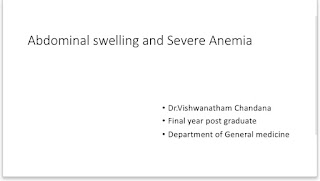CME speaker notes Spleen
Slide 1,2:
Good morning everyone
After an extensive case presentation by Dr.Raveen ,we are also as confused as you people ,with the diagnosis.That is the complexity we want to show you all.
So here we stand in the centre of the slide confused with our differentials.
Initial suspicion was Auto immune spectrum of diseases,Vitamin b12 deficiency
Later due to progressive splenomegaly Treatment was also given for tropical splenomegaly and NCPF was considered.
Other differentials like CVID,Rosai drofman were also considered in between
And in the end the biopsy came out to be likely storage disorder and NCPF.
Vitamin B12 is essential for normal DNA synthesis and nuclear maturation to maintain normal hemopoiesis.It is also required to maintain normal integrity of nervous system.
These patients present with Weakness,sore throat and paraesthesias(glove and stock distribution),beefy tongue,mild jaundice,Organomegaly,
Pancytopenia,Hyper-segmented neutrophils,low Retic count.
Oral iron supplementation was also given in view of few pencil forms in smear for 6months
As India is an endemic country for malaria whenever a patient presents with splenomegaly ,This should be kept in mind as one of the differential.
Diagnostic criteria for Hyper reactive malarial splenomegaly is
1.The exclusion of other causes of splenomegaly ,which is practically not possible until unless it’s histopathologically proven that there is no other known cause of splenomegaly
2.Immunity to malaria-Strongly positive antibody test
3.splenomegaly of atleast 10cms
4.A serum concentration of IgM atleast 2 Standard deviations above normal
5.Clinical and immunological response to malaria prophylaxis
Due to unexplained splenomegaly this patient was treated at outside hospital with Primaquine,Artemether and Lumefrantine but patient failed to respond.
Coming to his childhood history of diarrhoea for 6months with suspicion of celiac disease,Autoimmune Thyroiditis with Anti thyroglobulin antibodies positivity and presenting to our hospital with auto immune haemolytic anemia ,auto immune spectrum of diseases were kept as a differential.Anyhow he did not fit into any one the Literature described classical auto immune poly glandular syndromes but we always suspected an underlying auto immune process going on.Clinical examination and Testicular size measured using USG ruled out hypogonadism which is seen in APS.
Our suspicion has gained strength when we reviewed the literature and found out that there is a known association between auto
Immune Thyroiditis and NCPF .
Also Known association of CVID,NCPF and AIHA along with history of recurrent cold cough URTI’s,CVID came into the list of differentials.
Autoimmune hemolytic anemias are a group of acquired disorders resulting from increased RBC destruction due to red cell auto antibodies.
AIHA are classified as Cold and warm agglutinin type based on interaction of auto antibody with red cell antigen which is dependent on temperature .
Warm antibody type:IgG antibodies active at 37•C which could be idiopathic or secondary to Auto immune disorders(like SLE),Drugs like methyldopa and penicillins,Hodgkins and CLL.Colg agglutinin type is where IgM antibodies are active at 4•C to 18•C ,seen in mycoplasma ,infectious mononucleosis ,Lymphomas.
These patients present with anemia,Jaundice,Hepatosplenomegaly and manifestations of underlying disease.
Evidence of hemolytic anemia with spherocytes in smear and direct anti globulin test positive are indicative of AIHA and main line of treatment is with corticosteroids.
Splenectomy may be necessary in case of no response to steroids.IVIg is sometimes used as a temporary measure before performing splenectomy.Rituximab and other immunosuppressants are also used in refractory cases.
Here direct anti globulin test detects immunoglobulin (IgG) antibody and/or C3 complement on patients RBCs.Patients red cells are washed and suspended in saline.Anti globulin serum is added.Agglutination of red cells indicates the presence of anti body on the surface of RBCs.
Our patient has a transient response to steroids ,which was given along with B12 and later was re admitted with pancytopenia again.
Later one more differential of Rosai drofman was considered as repeat inguinal lymph node biopsy looked like histiocytosis.
As shown in this flow chart sporadic variant Rosai drofman has an association with AIHA and also splenomegaly can be there rarely.
- Rosai-Dorfman disease (RDD), also called sinus histioctosis presents with massive lymphadenopathy, is a rare histiocvtic proliferation of unknown etiology, usually occurring in children and adolescents.
- It is characterized by massive and painless bilateral cervical lymphadenopathy accompanied by fever, leukocytosis, elevated erythrocyte sedimentation rate, and polyclonal hypersammaglobulinemia
- More than 40% of patients have an extranodal involvement, and commonly affected sites are the upper respiratory system, skin, eyes, bones, genitourinary system, oral cavity, central nervous system, and soft tissue.
- The spleen is an infrequent site of disease, and if involved, combined nodal and extranodal disease is more frequent
NCPF/IPH is one of the important disease entities comprising noncirrhotic portal hypertension, a group of diseases that are characterized by an increase in portal pressure, due to intrahepatic or prehepatic lesions, in the absence of cirrhosis of the liver.
It is characterized by periportal fibrosis and involvement of small and medium branches of the portal vein, resulting in the development of portal hypertension. The liver functions and structure primarily remain normal
Two diseases which present only with features of PHT and are common in developing countries are NCPF and extra-hepatic portal vein obstruction (EHPVO). Non-cirrhotic portal fibrosis is a syndrome of obscure etiology, characterized by 'Obliterative portovenopathy' leading to PHT, massive splenomegaly, repeated well tolerated episodes of variceal bleeding and anemia in young adults from low socio-economic strata of life. The hepatic parenchymal functions are nearly normal. Jaundice, ascites and hepatic encephalopathy are rare. Management of variceal bleeding remains the main concern as nearly 85% of patients with NCPF present with variceal bleeding. Endoscopic variceal ligation or sclerotherapy are equally effective in about 90-95% of the patients. Gastric varices are seen in about 25% patients and a bleed from them can be managed with cyanoacrylate glue injection or surgery.
Other indications for surgery include failure of endoscopic therapy to control acute bleed and symptomatic hypersplenism.
The prognosis of patients with NCPF is good and 5-years survival rates in patients in whom variceal bleeding can be controlled is about > 95%.
Features of NCPF in our patient are Massive splenomegaly and Dilated portal vein.Whereas Ascites and varices were absent.
But as the spleen is removed now all the portal pressure may get diverted and can result in Varices .We need to follow him up to see what really happens.
Questions left unanswered in 14M with splenomegaly if it is storage disorder
1.If its storage disorder..Which storage disorder??
2.Cause of his widespread lymphadenopathy in cervical, inguinal
CT chest and abdomen-pre and para tracheal sub carinal and mesentric lymphadenopathy-?Rosai drofman/Reactive lymphadenopathy
3.Cause of his auto immune phenomenon in between (AIHA,Thyroiditis)?
4.Cause of Liver being reported as NCPF?Was it really NCPF or portal fibrosis in association with storage disorder?
So coming to storage disorders:
Splenic biopsy showed foamy cells with vacuolated cytoplasm which is usually seen with lysosomal storage disorders such as niemann pick but foamy transformation of gaucher cells has been reported rarely
Foamy transformation of macrophages is typically seen in lysosomal storage disorders in patients with Niemann-Pick disease, but foamy Gaucher cells (GC) were previously reported only once, in the autopsy report. Although the majority of stored glucocerebroside in GC is of erythrocyte origin, apparent erythrophagocytosis by GC in bone marrow is an unusual finding. Here, we describe the case of an adult non-Jewish Caucasian male with a heterozygous Gaucher disease type 1 who presented with atypical morphology of GC on bone marrow examination. Approximately 15% of his GC showed a notable erythrophagocytic activity or unusual appearance of foamy transformed macrophages with a great number of vacuoles and erythrocyte rests in the cytoplasm. This report highlights the fact that morphological examination of cells and tissue specimens is very helpful in the diagnosis of a storage disorder but that confirmatory testing for specific diseases should always follow. Moreover, it is now clear that Gaucher disease should be a part of the differential diagnosis of foamy transformed macrophages
https://pubmed.ncbi.nlm.nih.gov/21113739/
If we suspect Tay sachs?
There is No developmental regression in first year of life
no macrocephaly
no hyperacusis
death usually occurs in 2-4yrs age
Mainly No Hepatosplenomegaly in tay sachs
So tay sachs is not the storage disorder to be considered in this patient.
?Niemann pick
type A:
No feeding difficulty in childhood
Hepatomegaly will be more than splenomegaly in this disorder
Neurological decline,deafness,blind,spasticity not there
death is usually in 3years
So not considered
Type B Niemann
Milder course with no neurological involvement-Yes
Hepatosplenomegaly-yes
Ataxia-No
Hypercholestrolemia-No
Type C niemann
Hepato splenomegaly-Yes
neurological deterioration-No
Dystonia-No
cherry red spot-?(fundoscopy not yet done)
Vertical opthalmoplegia-No
Fabry disease
Severe extremity pain(acroparaesthesia)-No
Angiokeratoma-No
Corneal opacities-No
nephropathy-No
cardiac disease-No
Normal intelligence-yes
Cerebrovascilar disease -No
Gauchers
Type 1 is non neuropathic
It is the most commmon one
splenomegaly>Hepatomegaly -Yes
anemia-Yes
bleeding tendency-Thrombocytopenia-yes
Abdominal pains-Splenic infarcts
Skeletal pain and deformities-No
type 2,3 -Neuropathic ,severe CNS involvement -No
But Bone marrow aspirtation showed no Gaucher cells
1.Gauchers and its association with Auto immune phenomenon -Yes
Our pt had AIHA,Thyroiditis
2.Association of Gauchers and Hepatic firbosis? -Yes
As his liver biopsy reported as NCPF
---------------------------
GAUCHERS -AUTOIMMUNITY-LYMPH NODES
(As pt has storage disorder,AIHA,AI thyroiditis, Widespread lymphadenopathy)
https://www.sciencedirect.com/science/article/pii/S0006497119611390
There is an article showing Increased Incidence of Autoimmune and Lymphoproliferative Disorders in Gaucher Patients Accompanied with Significantly Impaired Dendritic Cell Function
Thirty three GD patients, followed at the Gaucher clinic of the Rambam Health Care Campus (Haifa, Israel), were enrolled
Thirty three type I GD patients, 19 males and 14 female
Eight (24%) patients presented with clonal lymphoproliferative disorders, including malignant lymphoma , multiple myeloma and monoclonal gammopathies .In 15/33 patients, autoimmune phenomena were revealed. In 12/15 thrombocytopenic GD patients, platelet antibodies were detected, suggesting immune etiology of their thrombocytopenia. Antiphospholipid and antiDNA antibodies were found in 3 other patients with no clinical evidence for autoimmune complications. All these complications appeared prior to the administration of enzyme replacement therapy (ERT).
So there is known association between Gauchers and auto immunity
GAUCHERS -MASSIVE HEPATIC FIBROSIS?
(As his liver biopsy at outside hospital reported as NCPF and in our hospital as Foamy cells with vacuolated cytoplasm and central nuclei)
https://pubmed.ncbi.nlm.nih.gov/10787452/
Hepatomegaly is frequent in patients with type 1 Gaucher's disease and is associated with infiltration of the liver with pathological macrophages. Most patients suffer no significant clinical consequences, but a few develop portal hypertension which may progress to parenchymal liver failure. This article describes four patients with Gaucher's disease who have developed portal hypertension. All had severe Gaucher's disease with multi-organ involvement, and had undergone splenectomy in childhood. Histologically, this advanced liver disease was characterized by a picture of extreme and advanced confluent fibrosis occupying the central region of the liver. This massive fibrosis is associated with characteristic radiological appearances.Our studies indicate that without specific treatment the liver disease is progressive and rapidly fatal. However, institution of enzyme replacement therapy with imiglucerase may have beneficial effects even when the condition is far advanced
So the NCPF can happen due to Gauchers also
GAUCHERS -WHY NO BONE INVOLVEMENT?
https://pubmed.ncbi.nlm.nih.gov/12902415/
In the most common form of the disease (type 1), accumulation of glucosylceramide in the reticuloendothelial cells of liver, spleen, and bone marrow leads to visceromegaly, anemia, thrombocytopenia, and osteopenia. Skeletal manifestations secondary to infiltration of the bone marrow by Gaucher's cells are detectable by radiography only in advanced stages.
*Current concerns:*
If it is only IPH/NCPH -Nothing much can be done ,just wait and watch
if it is storage disorder
if it is gauchers
Then enzyme replacement therapy can be started.
If it is gauchers why were Gauchers cells not visible on bone marrow aspiration but foamy cells visible in liver and spleen?
Is there any need to repeat Bone Marrow?
Sensitivity and specificity of visibility of Gaucher cells on bone marrow?
Sensitivity and specificity of various Enzyme assays(chitotriosidase,glucosylsphingosine etc)
Any need to send blood for enzyme assays?
Any other storage disorders with foamy cells with vacuolated cytoplasm fitting well into this patient?



















Comments
Post a Comment